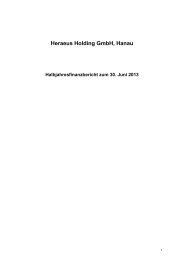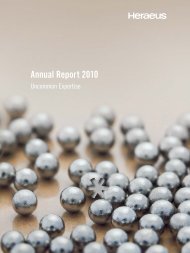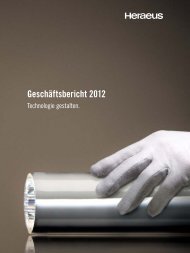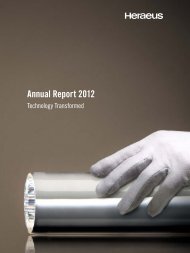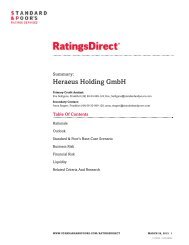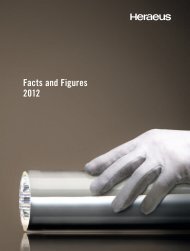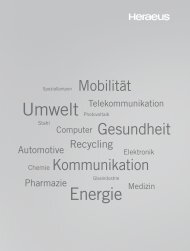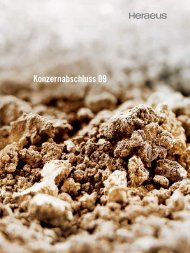english - About Heraeus
english - About Heraeus
english - About Heraeus
You also want an ePaper? Increase the reach of your titles
YUMPU automatically turns print PDFs into web optimized ePapers that Google loves.
08<br />
notes to the Consolidated Financial statements<br />
of <strong>Heraeus</strong> Holding GmbH, Hanau, for financial year 2012<br />
Basis oF pResentation<br />
The consolidated financial statements for the <strong>Heraeus</strong> Group issued by <strong>Heraeus</strong> Holding<br />
GmbH as the parent company have been prepared in accordance with standard accounting<br />
and valuation principles. In accordance with Section 315a HGB, the International Financial<br />
Reporting Standards (IFRS) issued by the International Accounting Standards Board (IASB)<br />
and the International Financial Reporting Interpretations Committee (IFRIC), which are<br />
endorsed by the European Union and are valid as of the balance sheet date, as well as the<br />
additional commercial law requirements to be applied in accordance with Section 315a<br />
HGB (1), have been applied.<br />
The financial year encompasses the calendar year. The consolidated financial statements<br />
were prepared in euros. Unless noted otherwise, all amounts are stated in millions of euros<br />
(€ million).<br />
To improve the clarity of presentation and transparency of the annual financial statements,<br />
various items in the balance sheet and income statement have been combined and stated<br />
separately in the notes to the consolidated financial statements. The income statement has<br />
been prepared using the nature of expense method. The balance sheet is divided by the<br />
maturity of the assets and liabilities. Assets are considered current if they are intended to<br />
be sold within one year or within the company’s normal business cycle. Liabilities are<br />
considered current if they are due within one year or within the company’s normal business<br />
cycle. The normal business cycle is defined as beginning with the procurement of the<br />
resources necessary for the production process and ending with the receipt of cash or cash<br />
equivalents as consideration for the sale of the goods or services produced in that process.<br />
Trade receivables and payables and inventories are always presented as current items.<br />
Deferred tax assets and liabilities and pension provisions are presented as non-current<br />
items.<br />
On March 8, 2013, the Board of Management released to the Supervisory Board the consolidated<br />
financial statements and the group management report issued on December 31,<br />
2012.




